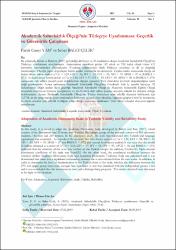Akademik Sahtekârlık Ölçeği’nin Türkçeye uyarlanması: Geçerlik ve güvenirlik çalışması
Künye
Yam, F. C. ve Balcı Çelik, S. (2021). Akademik Sahtekârlık Ölçeği’nin Türkçeye uyarlanması: Geçerlik ve güvenirlik çalışması. Manas Sosyal Araştırmalar Dergisi, 10(1), 70-81.Özet
Bu çalışmada Bahsir ve Bala’nın (2017) geliştirdiği altı boyut ve 23 maddeden oluşan Akademik Sahtekârlık Ölçeği’nin Türkçeye uyarlanması amaçlanmıştır. Araştırmanın örneklem grubu 182 erkek ve 230 kadın olmak üzere 412 üniversite öğrencisinden oluşmaktadır. Uyarlama çalışmasında ölçek Türkçeye çevrilmiş ve dil eş değerliği incelenmiştir. Ölçeğin yapısı doğrulayıcı faktör analizi yöntemiyle incelenmiştir. Yapılan analiz sonucunda ölçeğe ait birinci düzey faktör analizi (x 2 /sd = 3.21, GFI = .98, IFI = . 93, CFI = .93, NFI = .91 AFGI = .97 ve RMSEA = .073) ve ikinci düzey faktör analizi (x 2 /sd = 3.24, GFI = .97, IFI = . 93, CFI = .93, AFGI = .96 ve RMSEA = .074) sonucunda elde edilen model uyum indekslerinin ölçeğin yapısının Türk örneklemi üzerinde doğrulandığına işaret ettiği görülmüştür. Ayrıca çalışmada Akademik Sahtekârlık Ölçeği’nin Cronbach Alfa iç tutarlık katsayısı .92 bulunmuştur. Diğer açıdan ölçüt geçerliği Akademik Sahtekarlık Ölçeği ile Akademik Sahtekârlık Eğilimi Ölçeği arasındaki korelasyon katsayısı hesaplanmış ve iki ölçekten elde edilen puanlar arasında anlamlı bir ilişkinin olduğu belirlenmiştir. Ayrıca Akademik Sahtekârlık Ölçeği'nin Türkçe formunun ayırt edicilik düzeyini belirlemek için %27’lik alt-üst grup madde puan ortalamaları farklarının anlamlı olup olmadığı, bağımsız gruplar t-testi ile incelenmiş ve ölçme aracının ayırt edicilik özelliğine sahip olduğu sonucuna ulaşılmıştır. Elde edilen sonuçlar alanyazın ışığında tartışılmıştır. In this study, it is aimed to adapt the Academic Dishonesty Scale developed by Bahsir and Bala (2017), which consists of six dimensions and 23 items, into Turkish. The sample group of the research consists of 412 university students, 182 men and 230 women. In the adaptation study, the scale was translated into Turkish and language equivalence was examined. As a result of the analysis, first-level factor analysis (x 2 /sd = 3.21, GFI = .98, IFI =. 93, CFI = .93, NFI = .91 AFGI = .97 and RMSEA = .073) and second-level factor analysis It was seen that the model fit indices obtained as a result of (x 2 /sd = 3.24, GFI = .97, IFI =. 93, CFI = .93, AFGI = .96 and RMSEA = .074) indicated that the structure of the scale was verified on the Turkish sample. In addition, Cronbach's Alpha internal consistency coefficient of the scale was found.92. On the other hand, the correlation coefficient between the criterion validity Academic Dishonesty Scale and Academic Dishonesty Tendency Scale was calculated and it was determined that there was a significant relationship between the scores obtained from the two scales. In addition, in order to determine the level of discrimination of the Turkish form of the scale, whether the difference between the 27% sub-upper group item score averages was significant or not was examined with the independent groups t-test and it was concluded that the measurement tool had a distinguishing property. The results obtained were discussed in the light of the literature.
















